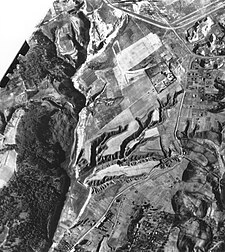Syrets concentration camp
| Kiev-West | |
|---|---|
Concentration camp | |
 Luftwaffe aerial photograph of Babi Yar, taken 26 September 1943 (shortly after the destruction of graves was complete). | |
| Other names | Syrez, Syrezky, or Syretskij |
| Known for | A Sonderaktion 1005 action to remove evidence of the Babi Yar massacres |
| Location | Babi Yar, a ravine near Kyiv, Ukraine (nowadays inside the city) |
| Operated by | Einsatzgruppen, Ordnungspolizei, Ukrainian Auxiliary Police |
| Commandant | Erich Ehrlinger, Paul Radomski, Paul Blobel, and others |
| Number of inmates | 327, including 100 Jews |
The Kiev-West (in German sources) or Syrets (
Establishment and location
The concentration camp was established in 1942 at the former summer camp of the Kyiv garrison on the northern edge of the city of Kyiv,
The camp was built in June 1942 at the request of
Camp operation
The prisoners (women and men) were housed in wooden barracks and in dug-outs with doors and stairs leading down from the ground level to prevent them from freezing up in winter.[2] The inmates were underfed and many starved to death, with daily mortality of around 10–15 people. Sturmbannführer Paul Radomski ran a terror regime in the camp with the aid of Kommandant Anton Prokupek and a company of Sotniks. For the smallest misdemeanours, he imposed heavy punishments and often struck the prisoners with the whip.[2] Radomski also used his German shepherd pet, Rex, to attack inmates.[3]
The sadism of the camp administration convinced many inmates to flee, despite the penalty of death. Guards were not immune, with some arrested or subject to solitary confinement if they helped.[3]
Inmate revolt
During the
... in those half-naked men who reeked of putrefying flesh, whose bodies were eaten by scabies and covered with a layer of mud and soot, and of whose physical strength so little remained, there survived a spirit that defied everything that the Nazis' New Order had done or could do to them. In the men whom the SS men saw only as walking corpses, there matured a determination that at least one of them must survive to tell the world about what happened in Babi Yar.[1]
On the night of September 29, 1943, as the camp was being dismantled, an inmate revolt broke out. The prisoners overpowered the guards using their bare hands, hammers and screwdrivers. Fifteen people managed to escape. Among them was Vladimir Davіdov, who later served as a witness at the Nuremberg Trials.[4] Among other escapees were Fyodor Zavertanny, Jacob Kaper, Filip Vilkis, Leonid Kharash, I. Brodskiy, Leonid Kadomskiy, David Budnik, Fyodor Yershov, Jakov Steiuk, Semyon Berland, Vladimir Kotlyar.[5] Once Nazi control was re-established in the camp, the remaining 311 inmates were executed.
After the camp's liberation, Soviet authorities took a group of American, British, and Soviet correspondents to the site of the Babi Yar massacres.
However, even more incredible was the actions taken by the Nazis between August 19 and September 28 last. Vilkis said that in the middle of August the SS mobilized a party of 100 Russian war prisoners, who were taken to the ravines. On Aug. 19 these men were ordered to disinter all the bodies in the ravine. The Germans meanwhile took a party to a nearby Jewish cemetery whence marble headstones were brought to Babii Yar [sic] to form the foundation of a huge funeral pyre. Atop the stones were piled a layer of wood and then a layer of bodies, and so on until the pyre was as high as a two-story house. Vilkis said that approximately 1,500 bodies were burned in each operation of the furnace and each funeral pyre took two nights and one day to burn completely. The cremation went on for 40 days, and then the prisoners, who by this time included 341 men, were ordered to build another furnace. Since this was the last furnace and there were no more bodies, the prisoners decided it was for them. They made a break but only a dozen out of more than 200 survived the bullets of the Nazi Tommy guns.[7]
According to Vilkis, some of the prisoners grew ill or went mad from the experience, and Nazi guards killed them as a warning to the rest. Three to five prisoners were shot each day.[8]
Camp for German POWs
When the
See also
- List of Nazi-German concentration camps
- The Holocaust
Notes
- ^ a b c Martin Gilbert (1985), Holocaust, quoted online in "Babi Yar" by The Berdichev Revival. Retrieved April 25, 2013.
- ^ a b c d ARC (July 9, 2006). "The KZ in Syrets". Occupation of the East. Deathcamps.org. Retrieved 2013-04-26.
- ^ a b c Aristov, Stanislav (2015). "Next to Babi Yar: The Syrets Concentration Camp and the Evolution of Nazi Terror in Kiev". Holocaust and Genocide Studies. 29 (3): 431–459 – via Oxford Academic.
- ^ Gilbert (1985): 613. 1943 September 30, Sonderkommando Babi Yar Revolt
- ISBN 0-02-896090-4. An excerpt of the article is available at Ada Holtzman, "Babi Yar: Killing Ravine of Kiev Jewry – WWII", We Remember! Shalom!.
- ^ Lawrence, W. H. (November 29, 1943). "50,000 Kiev Jews Reportedly Killed". The New York Times. Retrieved 27 December 2022.
- ^ Downs, Bill (December 6, 1943). "Blood at Babii Yar - Kiev's Atrocity Story". Newsweek: 22.
- ISBN 9780841501430.
